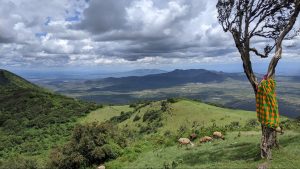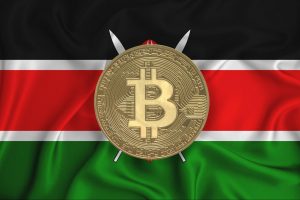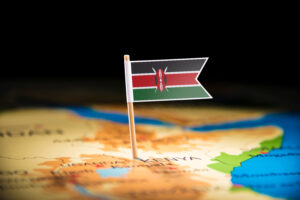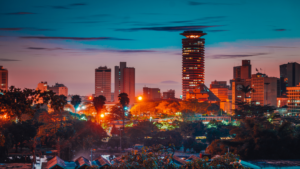Having lived in the city most of my life, I find the weather in Nairobi stable and tolerable. Since Nairobi is situated close to the equator, the differences between the seasons are minimal.
That said, the weather here can be fickle sometimes. It can be bright and sunny, then rain in the next heartbeat. With such mercurial weather, it can be tricky to forecast.
But as a long-time Nairobian, I feel like I have a handle on the weather. So, here’s a Nairobi weather guide to help you figure out what to expect ahead of your move or visit.
Quick Facts About Weather in Nairobi
- For most of the year, the weather in Nairobi is hot, humid, and tropical.
- Seasons in Kenya are either wet or dry.
- There are two different rainy seasons; short rains and long rains.
- Long rains are from March to May and short rains from October to December.
- The annual average rainfall in Nairobi is 925 mm(36.4 inches).
- The coldest days are in July. Locals call this the African winter; it may not rain, but temperatures can dip to single digits.
- The hottest days are in January and February.
- It rarely gets too hot or too cold in Nairobi.
- The weather affects traffic in Nairobi; heavy downpours slow the flow of vehicles and often result in gridlock.
Seasons in Nairobi
Wet Seasons
There are two wet seasons in Nairobi: from March to May, then from October to December.
The wet seasons occur as long rains and short rains.
During the wet seasons, it doesn’t always rain the whole day. Some days, it’ll stay dry and warm during the day and rain in the afternoon or evening or vice versa.
I would advise you to pack a raincoat, warm sweater, or jacket if you visit during this season. Depending on your activities, you might also need rain boots for muddy roads.
Long Rains (March-May)
March to May is the primary rainfall season for Nairobi and most of Kenya. The peak of the rains is usually in April.
The rain can be torrential and sometimes causes drainage ditches to overfill and big puddles to build up by the side of the roads.
But don’t worry, the rain comes down in bursts during this period. So there are still lots of sunny spells and warm temperatures to enjoy in Nairobi.
This season isn’t very active in tourism; you might get great deals on safaris to the Maasai Mara or holidays to the coast.
Short Rains (October-December)
During the October to December period, there are shorter rains in Nairobi.
Despite the depressed rains during this period, there are incidences of storms that may cause flash floods.
Just like the long rains, the short rains also come in bursts, and you can still enjoy warm weather, especially during the day.
Dry Seasons
The dry seasons occur between January and February and June to September.
You’ll get the most sunshine in February and August.
Although it doesn’t always rain in June and July, it’s usually pretty cold during this period. Many people typically don’t expect it to be chilly and don’t come prepared; consider this your heads up.
Weather in Nairobi By Month
January
January is a hot month in Nairobi. The city gets up to 12 hours of daylight and up to nine hours of sunlight throughout the day.
Average temperature: Average maximum temperature is 25.7°C (78.3°F), and the minimum temperature is 13.4°C (56.1°F).
Chance of Rain: The chances of rain during the day average at only 13%. It rains 4 days a month. The total amount of expected rainfall throughout the month is up to 45 mm (1.8 inches).
February
February is the last month of Kenya’s summer season and is a hot month in Nairobi. There’s an average of 9.6 hours of sunshine and 12.2 hours of daylight during the month.
Average temperature: The maximum temperature is 27°C (80.6°F). The minimum temperature is 14.3°C (57.7°F).
Chance of Rain: The chances of rain during the day average at 14%. Though not an exact science, you can expect it to rain for 4 days in the month. The expected rainfall throughout the month is up to an average of 51 mm (2 inches).
March
In March, the weather in Nairobi can be rainy; the long rains typically begin in the middle of the month. It’s important to note that it still gets warm, especially at the beginning of the month.
Average temperature: Average temperatures range between a maximum of 26.8°C (80.2°F) and a minimum of 15.3°C (59.5°F).
Chance of Rain: There’s a 29% chance that it’ll rain during the day, and the number of wet days averages 9. The total amount of rainfall in the month is up to 101mm (4 inches)
April
April has the most rainfall in the year. It has the least amount of sunshine at an average of 8.5 hours of sun throughout the day.
Average temperature: The average temperature ranges between a maximum of 24.7°C (76.5°F) and a minimum of 15.6°C (60.1°F).
Chance of Rain: There’s a 50% chance that it’ll rain during the day, and the number of wet days averages 15. The total amount of rainfall in the month is up to 206mm (8 inches)
May
Like April, May has the least amount of sunshine, with an average of 8.5 hours of sun throughout the day.
Average temperature: The average temperature is between a maximum of 22.9°C (73.2°F) and a minimum of 14.2°C (57.6°F).
Chance of Rain: There’s a 45% chance of rain, and the number of wet days averages 14. The total amount of rainfall in the month is up to 160mm (6.3 inches)
June
June kicks off the dry season in Nairobi. Although it doesn’t rain as much, it can get cold. June is the beginning of Kenya’s winter season.
Average temperature: The average temperature is between a maximum of 22.4°C (72.3°F) and a minimum of 13.2°C (55.8°F).
Chance of Rain: There’s a 20% chance of rain during the day, and the number of wet days averages 6. The total amount of rainfall in the month is up to 46mm (1.8 inches)
July
July is the driest month in Nairobi. It is also the coldest period.
Average temperature: The average temperature with average temperature is between a maximum of 22.6°C (72.7°F) and a minimum of 12.7°C (54.9°F). You should note that sometimes the temperature falls to single-digit numbers in July.
Chance of Rain: There’s a 10% chance of rain during the day, and the number of wet days averages 3. The total amount of rainfall in the month is up to 19mm (0.7 inches)
August
The weather in Nairobi starts to turn moderately hot in August.
Average temperature: The average temperature with average temperature is between a maximum of 23°C (73.4°F) and a minimum of 13.8°C (56.8°F).
Chance of Rain: There’s a 13% chance of rain during the day, and the number of wet days averages 4. The total amount of rainfall in the month is up to 26mm (1 inch)
September
September is generally a warm month in Nairobi. It is the beginning of Kenya’s Spring.
Average temperature: The average temperature with average temperature is between a maximum of 24.6°C (76.3°F) and a minimum of 14.2°C (57.6°F).
Chance of Rain: There’s a 13% chance of rain during the day, and the number of wet days averages 4. The total amount of rainfall in the month is up to 26mm (1 inch)
October
Typically the short rains start in October. The temperature during the day is still relatively warm.
Average temperature: The average temperature is between a maximum of 25.3°C (77.5°F) and a minimum of 15.3°C (59.5°F).
Chance of Rain: There’s a 19% chance of rain during the day, and the number of wet days averages 6. The total amount of rainfall in the month is up to 54mm (2.1 inches)
November
November is also a moderately hot month in Nairobi. It tends to get humid during this month.
Average temperature: The average temperature with average temperature is between a maximum of 24°C (75.2°F) and a minimum of 14.9°C (58.8°F).
Chance of Rain: There’s a 40% chance of rain during the day, and the number of wet days averages 12. The total amount of rainfall in the month is up to 109mm (4.3 inches)
December
Although there’s still some rain, December often marks the beginning of Kenya’s summer season.
Average temperature: The average temperature with average temperature is between a maximum of 24.1°C (75.4°F) and a minimum of 13.9°C (57°F).
Chance of Rain: There’s a 26% chance of rain during the day, and the number of wet days averages 8. The total amount of rainfall in the month is up to 82mm (3.2 inches)
Weather & Climate Outside Nairobi
Depending on where you visit, the weather in different parts of Kenya can vary.
Like in Nairobi, most of Kenya experiences warm periods from February to March and cooler temperatures from June to August.
The average daytime temperature in the country lies between 20°C (68°F) and 28°C (82°F). However, places like the coastal region are warmer compared to most parts of the country.
The Coastal Regions
Temperatures at the coast of Kenya average highs of 31/32°C (88/90°F) but can rise to 36/37°C (97/99°F).
The hottest time is from November to March.
The temperatures drop down to 28/29°C (82/84°F) from June to August. It is more pleasant to visit during this time.
There could be little rain from January to February and in March and December. The coastal region experiences the long rains later than the rest of the country; it rains from April to June, with May being the wettest month.
However, don’t let the rain deter you from visiting; most of the time, showers at the coast are usually replaced by the sun soon after.
The Plateau/Highlands
The plateau includes regions like Eldoret, Nakuru, Maasai Mara, Kakamega, Kisumu, Amboseli, and Mount Kenya.
The climate is typically warm and mild in these regions, but temperatures vary depending on the altitude.
There’s a higher chance of rainfall in the mountains, and sometimes thunderstorms break out even during the dry season.
The regions experience long rains between March to May and short rains between October and December.
The Arid Regions
These are regions located in the North part of Kenya like Turkana, Mandera, and Wajir. The North is the driest and hottest area of Kenya.
The daily average temperature goes up to 30°C (86°F) in almost all months. The temperature might drop to 28/29°C (82/84°F) in July and August.
There’s sometimes rain during the wet season in March-May and October-December, but it is usually poor and irregular.
How to Pack for Weather in Nairobi
As I mentioned, temperatures vary in different parts of the country. What you pack will depend on where you’re going and your activities.
For the cold season (June to August), pack light clothes for the day, a sweater and a jacket for the evening, a raincoat, and an umbrella. Some people even invest in scarves and woolly hats.
If you are going to the coast, you can swap out the sweater and jacket for a sweatshirt for the evening. Remember to carry a scarf for the breeze.
For the warm or summer season (December to February), pack light clothes for the day and a jacket or sweater for the evening. At the coast, pack light clothing made of natural fibers and a lightweight sweatshirt for the evening.
Where To Shop For Clothes and Shoes in Nairobi
If you forget to pack enough or if the weather unexpectedly changes while you’re in Nairobi, there are several places you can shop for clothes.
Toi Market is an open-air market and a great place for unique second-hand and new clothes and shoes at affordable prices. It’s located on Ngong Road near Adams Arcade. The market is usually congested and you may need a local to help you move around and negotiate prices.
Decathlon is a sports equipment and sportswear retailer found in several malls in Nairobi. They are great if you’re looking for cold weather clothing. You can also shop on their excellent website.
Mr Price and LC Waikiki are good-value clothing stores found in most Kenyan malls. They have a wide variety of clothing and shoes.
Bata Kenya is a footwear company in Kenya with many stores all around Nairobi. They have all types of shoes for men, women and children.
Ngara and Gikomba are informal markets for second-hand clothes and shoes. They tend to get crowded and can be tricky to navigate – I would advise you go with a local.
Final Thoughts
Finally, predicting weather in Nairobi isn’t an exact science. There are so many factors that affect the weather. Climate change, for example, has led to widespread changes in weather patterns.
While this guide is helpful to get a general idea of what it’s like, it is constantly changing. I would recommend you look up forecasts for the days you intend to travel or move to Nairobi.
FAQ About Weather in Nairobi
The coldest month in Nairobi is July. The average temperature is at a maximum of 22.6°C (72.7°F) and a minimum of 12.7°C (54.9°F).
The type of weather in Nairobi, Kenya varies depending on the season. The seasons are either wet or dry. The temperature typically ranges from 12 °C (53.4 F) to 27 °C (80 F).
Nairobi does not have snow. There have been few instances of small hail storms.
Nairobi gets cold sometimes. Temperatures can drop up to 9 °C (48 F) and occasionally lower. The coldest month is July.
Wear loose-fitting clothes and comfortable shoes in Nairobi. Depending on the season, you may want to layer your clothing since the weather changes constantly. It can be cold in the morning but turn hot in the afternoon or vice versa.










